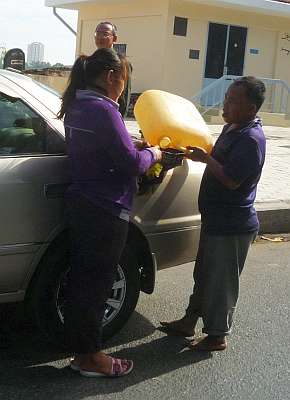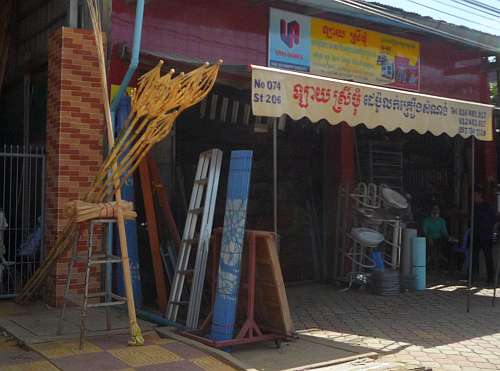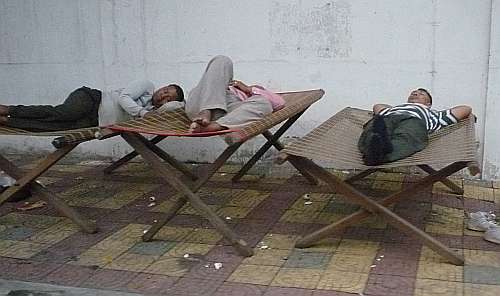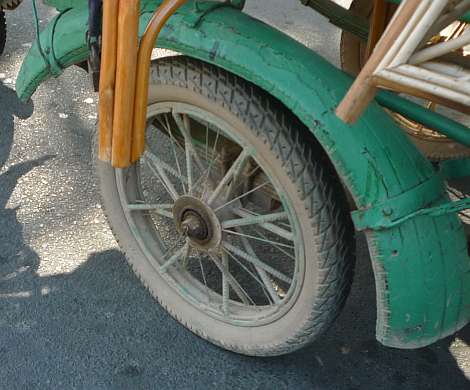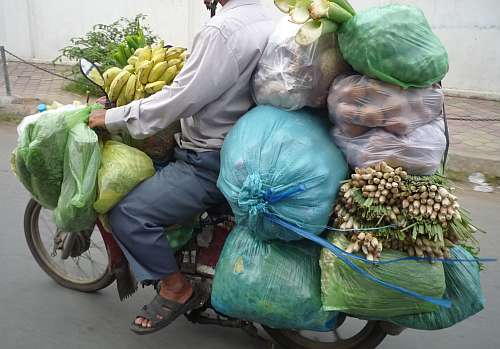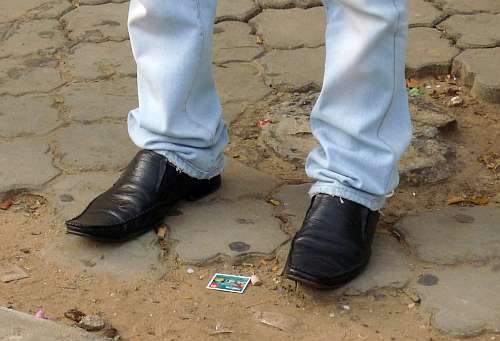|
|
|||||||||||||||||||||||||||||||||||||||||||||||||||||||
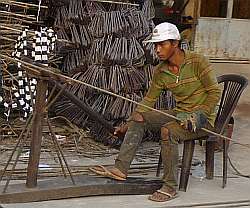 |
Click here for glimpses of Cambodia at work |
4 December 2011
"I guess if you want anything done, you have to do it yourself! ...At least it's not one of those big heavy wooden Cambodian chairs!" 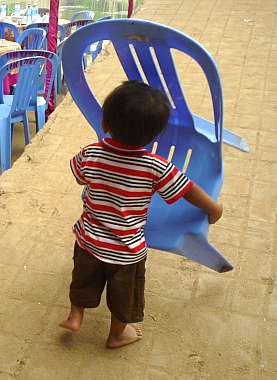
3 December 2011
This is a T-intersection near the Deaf Development Programme where two major streets come together. The picture doesn't really do justice to the chaos that prevails everyday but there are vehicles going every direction in all the lanes--and with no attempt at traffic control. There are no traffic lights, no police, and no will to do things differently. 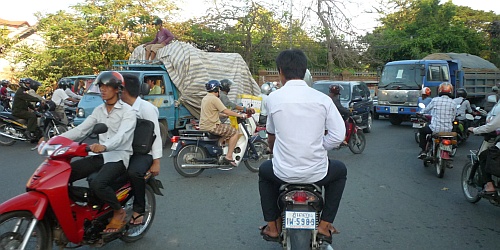
2 December 2011
It always seemed to me that balancing a high heel on the motorcycle footpeg would be something of a challenge for women riding motorcycles, but that seems to be the most common practice here in Phnom Penh. I'm guessing that women experienced in wearing high heels don't find it that difficult to keep the heel on the peg and just do it automatically. 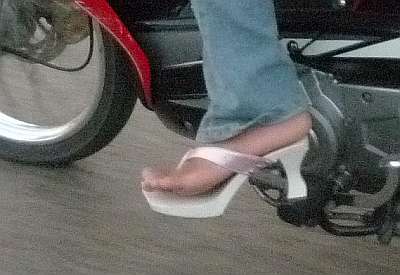
1 December 2011—Motorcycle Loads #157
"What am I going to do with them? I don't know...but I got them cheap!" 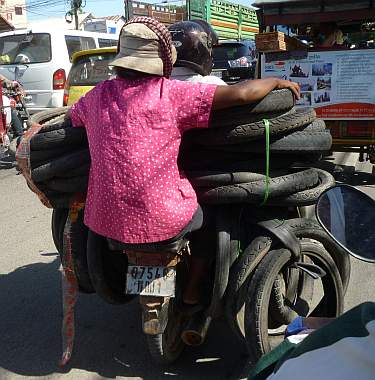
29 November 2011
These are jackfruits, probably one of the largest species in the fruit family. They rank right up there with watermelon in size, but unlike watermelon they grow hanging from trees. Inside the thick protective hull is a soft yellow fruit that comes apart in sections. It has a flavor that even most Westerners can like. 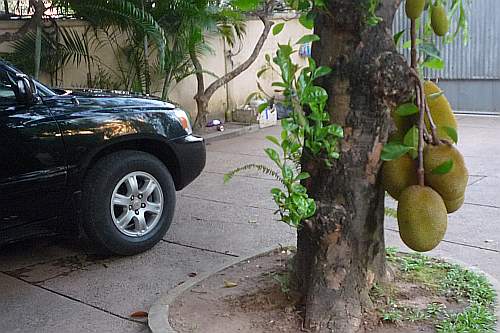
25 November 2011
Phnom Penh is not known for its night life. First of all, 90% of the country is in bed by 9:00 PM because only 17% of the country has electricity. Then it is quite dangerous to be out after dark in Phnom Penh. There are nightclubs and bars frequented by wealthy sons and daughters of the military and the well-heeled, and some of those places, even the U.S. Marine guards at the embassy are prohibited from patronizing. The mile or so of hotels, shops, and restaurants along the waterfront pictured here is fairly safe up to about midnight, but the danger is in going home. For that you need to be in groups and preferably in a car.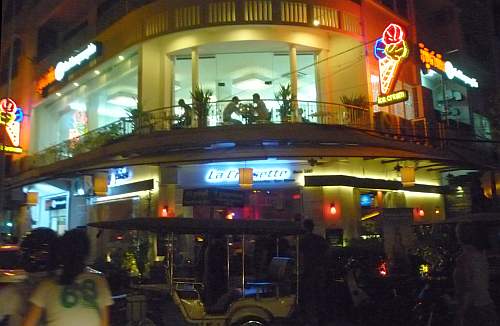
22 November 2011
I'm not sure what this fruit is--I'm not even sure if it is a fruit!—but it's the latest fruit to appear on the bicycles of the street vendors as the different fruits come into season. These fruits look like small, half-ripe tomatoes, but I think they are hard although I've not tasted them. 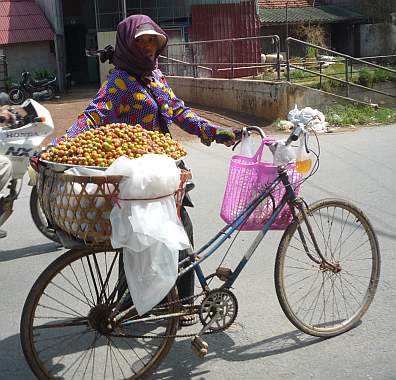
21 November 2011
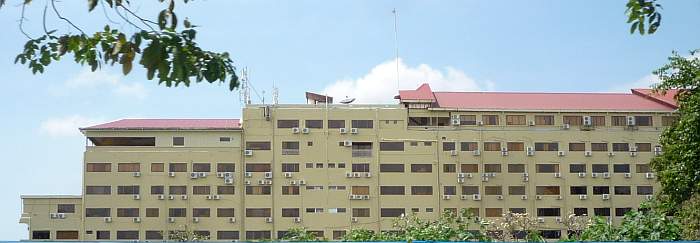
Something you don't see much in a developing country is this rash of individual air conditioning units dotting the exterior of a fairly new building. Actually you don't see it much in Cambodia either. Air conditioning is a fairly recent and fairly limited addition to the building scene here. Much more in vogue are windows that open. Modern, especially Western-oriented businesses are starting to demand air conditioning, though, so more and more individual units are added to existing structures. In addition to the negative cultural factor, developers also don't want to pay for air conditioning and this way can pass the cost on to the renter. Central air is hardly a consideration. It may be very difficult--and certainly very expensive--to add that to even a new building going up in Phnom Penh.
20 November 2011

Click here for pictures of building construction, Cambodian style
9 November 2011
Many of the job settings common among the working people of Cambodia, at least in the cities, almost remind one of the days of the Depression when people were happy to get any simple employment that offered some money. That goal is the basic motivating force in Phnom Penh today. So many people work in basic selling jobs along the streets, like this woman selling newspapers in the morning at a busy intersection. 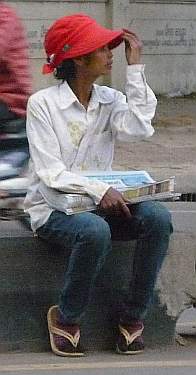
8 November 2011
Some of the women arrive by Lexus, some by bicycle. Some have their nails done in an air-conditioned spa, some in a street shop. Some pay a LOT of money, some pay a few riel. But they all probably go home feeling good. 
7 November 2011
It's mango season again! They are getting to a reasonable size on the trees in the yards around my house, and the first ripe ones--and the green ones favored by locals--are starting to be sold on the streets. Hooray! Mangoes are one of my favorite fruits. 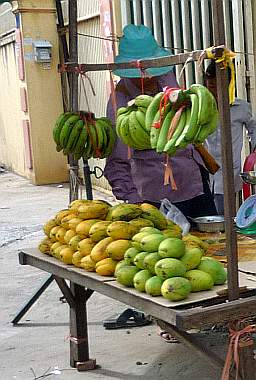
4 November 2011
Today's gas price (petrol, if you're British) was 5500 riel per liter. There are 3.78 liters per gallon and today's exchange rate was 4065 riel to $1.00. So...if you do the math, one liter costs $1.35 and there are 3.78 liters in a gallon, so $1.35 x 3.78 = $5.11 per gallon. Maybe that is why they are giving away cars and motorcycles to loyal customers at this French-owned petrol station. 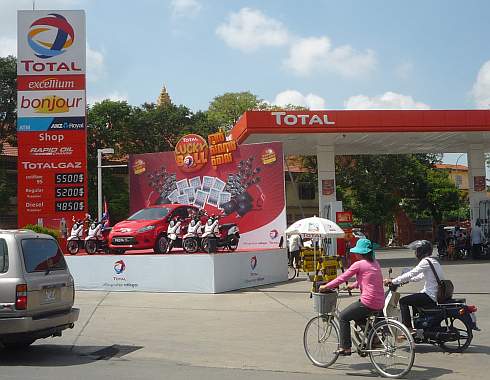
3 November 2011
No pink flamingos or little garden gnomes on Cambodia's lawns! Actually, there are no Cambodian lawns, at least not if my neighbors are a good indication. They get out in their yard--one of the few houses with a yard--and assiduously scrape off all the grass with knives and machetes to get down to the beautiful bare earth. But the absence of lawns doesn't stop Cambodians from erecting various kinds of statues around the city, and here is a sampling of a few different types on sale along the street in Phnom Penh.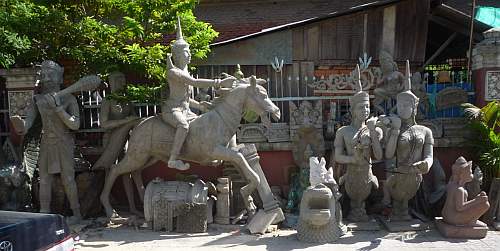
2 November 2011
An unusual load on a motorcycle, even for Phnom Penh: freshly cut grass for some urban cow and about 150 dozen eggs, all piled together. Maybe it's for an alfalfa omelette? 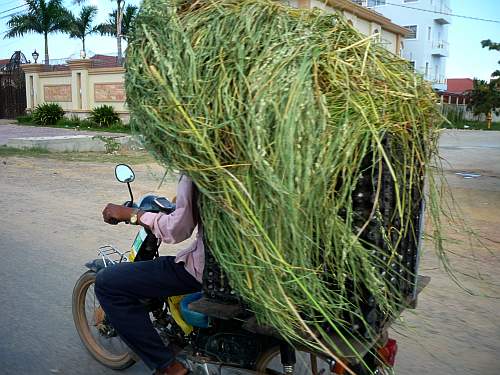
1 November 2011
Fish is very common part of the Cambodian diet and on any given day fresh fish are drying in the sun, prior to being cooked for supper. I'm not sure what the reason is for putting fish--and various meats--out in the sun all day. It seems that if they are going to be cooked in a few hours, the sun wouldn't make much difference but maybe it adds something to the taste? 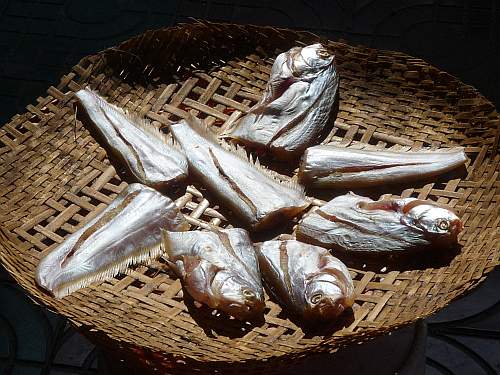
31 October 2011
Much preferred to soft drinks in Cambodia—and much more healthy--is the sugarcane juice that is sold on the streets, even in the small villages. A wringer, like on an old washing machine, is used to squeeze the juice from sugarcane stalks and then it is drunk directly from a glass or over ice. But before the cane can be squeezed, it must be peeled as this young man is doing. It's not an exciting job. 
29 October 2011
The scary part of this picture is that he may not be recycling these plastic water bottles but taking them to be filled! 
28 October 2011
Four years ago this "stream" was just a small waterway with dirt banks that ran through the Boeung Tum Pun area of Phnom Penh on its way to the Mekong River. Then about four years ago, the city channelized it, creating a concrete channel for it up to this grate (which was just installed three weeks ago). On city maps it looks like an actual stream but in reality it is an open sewer. Today this boy was paddling around in it, floating on a big piece of foam, collecting plastic bottles to sell. 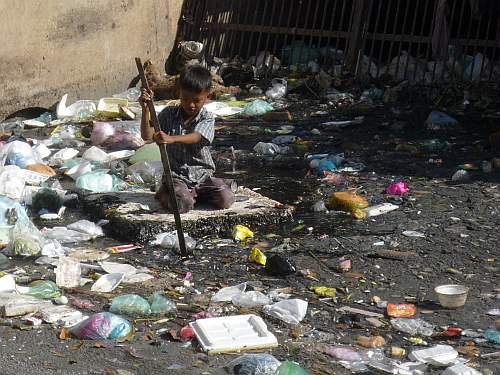
26 October 2011
Just as mobile phone technology basically leapfrogged over landlines, which never really became established in Cambodia, so LED signage and advertising has become more and more common rather than neon lighting. There are a few neon lights around--this store advertises neon signs in addition to the LEDs--but most of the bright and colorful signs appearing now on Phnom Penh streets utilize rather the newer LED technology. 
24 October 2011
The current floods in Thailand are making news around the world, especially since the capital Bangkok is threatened. The floods in Cambodia are similarly severe but the capital Phnom Penh is not at risk although 17 of 24 provinces are experiencing a great deal of damage and destruction. In the past two years, the city of Phnom Penh has rebuilt its riverfront with an aim toward flood protection, and that foresight has paid off as the Mekong and Tonle Sap Rivers have been held at bay. These are tourist boats tied up along the riverfront and riding out the flood crest with no problem. Normally the water level would be fifteen to twenty feet lower and these boats would not even be visible from the roadway. 
23 October 2011
Without changing leaves, sports seasons, variations in temperature, etc., it is hard to know the seasons of the year in Cambodia. Well...maybe it's actually easy. There are only two: hot and wet and then hot and dry. One indicator that the months move along, though, is the different fruits that appear in the vendors' carts. Now pomelos, a fruit similar in texture and taste to a grapefruit, are appearing. And I'm glad. It's probably my favorite fruit, along with mangoes. (Notice how much clothing these two are wearing, even though the temperature is in the 90ºs. Everyone seeks protection from the sun, the women so that their skin doesn't become darker.) 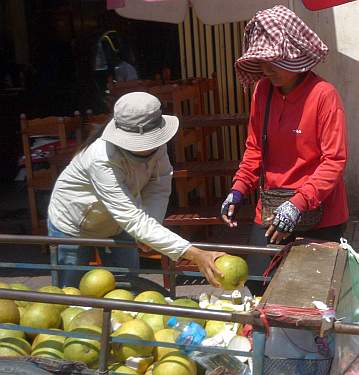
22 October 2011
Probably every person who builds a larger concrete house in Phnom Penh plans to rent out part of it, but many owners do not construct the building with staircases to provide for more than one family because that would cost money. Some families just have the renters traipsing back and forth through their living area on the way to the apartment upstairs. Others have these spiral staircases made to allow outside, private access to an upstairs flat. They are both difficult and inconvenient for normal daily life. And you can imagine how much trouble it is if you're trying to carry something upstairs! 
21 October 2011
Yesterday it was motorcycles loaded with bananas. Today its a cyclo, with its driver folding a foam mattress so that it will travel better on the delivery run. 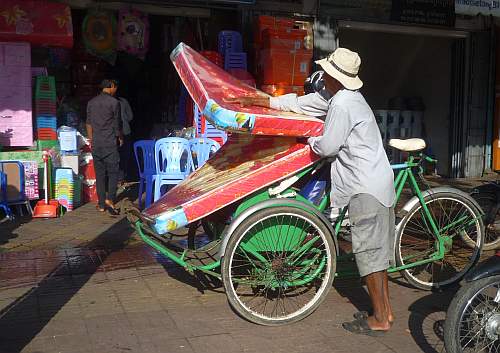
20 October 2011
Many people have heard of banana boats, the ships that carry bananas from Central America to North America and other parts of the world. The bananas in Cambodia don't travel quite as far and not in as much style. Bananas grow everywhere in the kingdom and most of them travel just short distances to local markets. Many of them travel on motorcycles like these, fitted with special racks.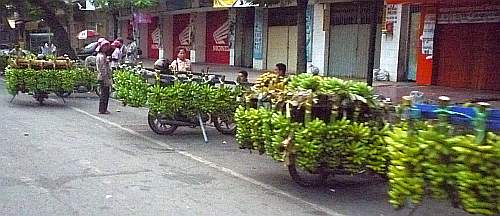
19 October 2011
Almost everyone who can afford it buys bottled water to drink. I described earlier how I buy ten of these big bottles of water at a time and the water company crew carry them up four flights of stairs to my home. This man is carrying his own bottle of water home from a small shop at the end of my street. These water bottles weigh 46 pounds each! 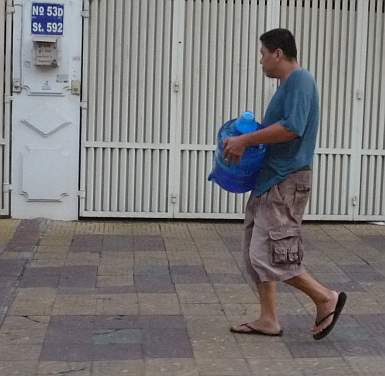
15 October 2011
One of Cambodia's greatest natural resources is its wood, especially its luxury hardwood forests (which are being plundered by government and military officials). Unfortunately every family seems to want their share of the forest wood and heavy, bulky furniture made from luxury woods is very common and very much desired. Probably Cambodia's lack of industry and fabrication ability using other materials has contributed to its focus on wooden furniture and furnishings. 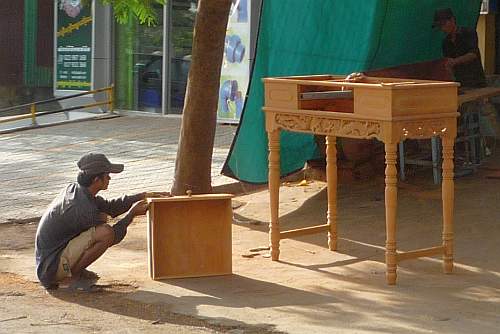
14 October 2011
"But it matches my jacket! ...And I drive carefully anyway." 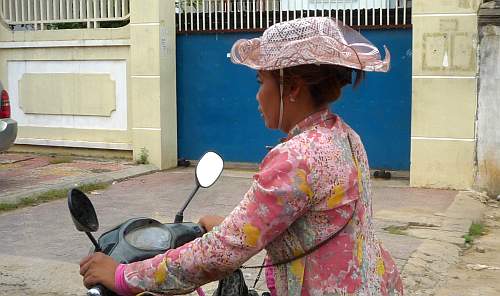
18 September 2011
Some of the confusing aspects of Cambodian life and culture I eventually come to understand after getting more experience--or explanation--of daily life here. Other parts of daily life continue to confound me. There are a series of little "shops" like this on the sidewalk on Sisowath Quay, along the river in Phnom Penh. Each of these men has different sizes of used motorcycle sprockets and chains hung up. The men spend all day pounding away on individual links of the motorcycle chains. (1) Why are there these specialty shops just for chains? Why don't people with a bad sprocket just go to one of the hundreds of stalls in the markets jammed with motorcycle parts? And (2) why do these men take apart the chains and pound each link? What are they doing?
17 September 2011
Motorcycle Loads #156 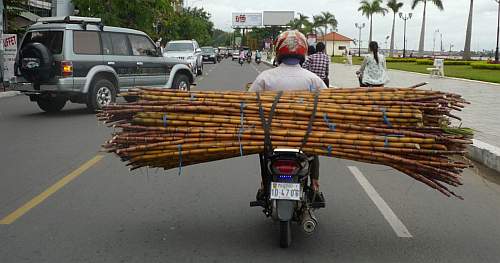
16 September 2011
As night descends a street vendor prepares food on a grill on the street as traffic swirls by. 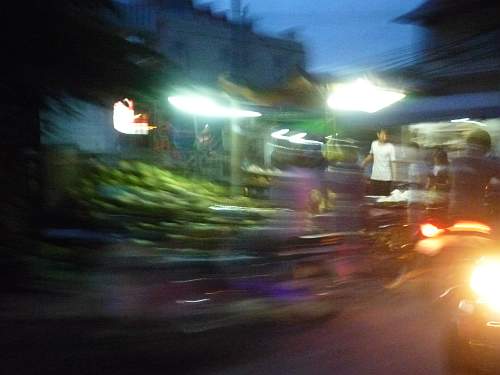
13 September 2011
Near Charlie's house is a Christian church where youth play football on Sunday evenings. They have a lighted paved area--there is no need of parking lots here--that the students use after the services as night falls. 
12 September 2011
In the preceding entry, I mentioned a hawker with a bicycle loaded with bread who was using a small mobile sound system to advertise her arrival and her wares. Here is a picture of a young man with a cart full of coconuts who is also wired for sound. 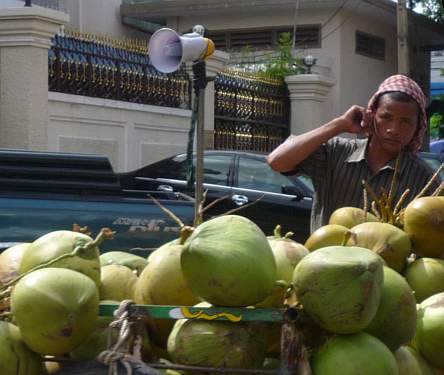
9 September 2011
When I first arrived in Phnom Penh more than a decade ago, hawkers and vendors plied the streets, some with bicycles or carts, some just on foot with bundles on their heads or in their arms. That hasn't changed. The economy still needs them. What has changed is that an element of high-tech has been added. Previously the vendors roamed the streets singing out the wares they offered, usually some kind of food. Today many, like this woman selling bread from a bicycle, have portable PA systems on their bikes to play a recorded and amplified sales pitch to all in the area. It has to be saving their voices! 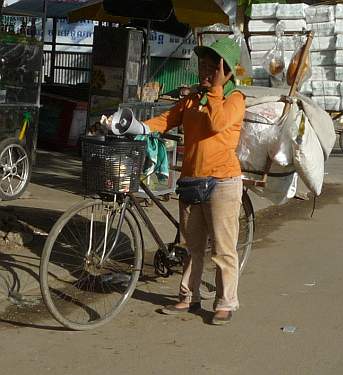
7 September 2011
So many people of every age spend their days collecting, disassembling, cleaning, repairing, recycling the trash of Phnom Penh. I suspect the large number of people dependent on the trash of a society is a really clear negative economic indicator. What is this young boy thinking? Maybe he is wishing he were in school like other young people his age. 
6 September 2011
Chaos... This is a major street leading into the area of Phnom Penh called Boeung Tum Pun. The street isn't very wide and because it's in front of the Boeung Tum Pun Market, it carries a huge amount of traffic. It is also basically the only street giving access to the neighborhood. Other streets are even more narrow and do not exit on to the main road in the background. 
5 September 2011
"Excuse me, Ma'am.... I can't seem to find the Asian Wall Street Journal !" 
4 September 2011
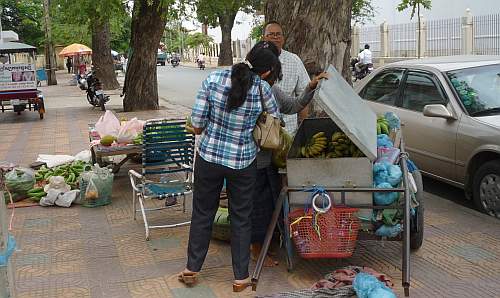 This is a street-side banana vendor making a sale to a couple who stopped their car to make a purchase. I had just bought a "hand" (as a bunch is known here) of bananas myself. My normal breakfast is a piece of toast and a tangerine but now a bag of seven small tangerines is more than $6, because they're out of season, so I have switched to bananas which are about 30¢ a pound. My problem is that I am the only one in my house right now so a bunch of ten or twelve bananas gets rather soft by the time I get to the last ones. Another, lesser, problem about buying bananas is deciding which ones to get. There are probably six or eight different sizes, shapes, and colors of bananas on the market here.
This is a street-side banana vendor making a sale to a couple who stopped their car to make a purchase. I had just bought a "hand" (as a bunch is known here) of bananas myself. My normal breakfast is a piece of toast and a tangerine but now a bag of seven small tangerines is more than $6, because they're out of season, so I have switched to bananas which are about 30¢ a pound. My problem is that I am the only one in my house right now so a bunch of ten or twelve bananas gets rather soft by the time I get to the last ones. Another, lesser, problem about buying bananas is deciding which ones to get. There are probably six or eight different sizes, shapes, and colors of bananas on the market here.
1 September 2011
Motorcycle Loads #155 
29 August 2011
This is a picture of Sunday morning at 9:00 AM. Can you guess what everyone is doing? This is the front entrance to the campus of the Royal University of Law and Economics in Phnom Penh, and these are all students arriving for classes. Sunday is just a day off in Cambodia. Since the country is Buddhist, there are no Sunday morning church services for the general population, just for the foreigners, so it's a perfect time to go to school. 
28 August 2011
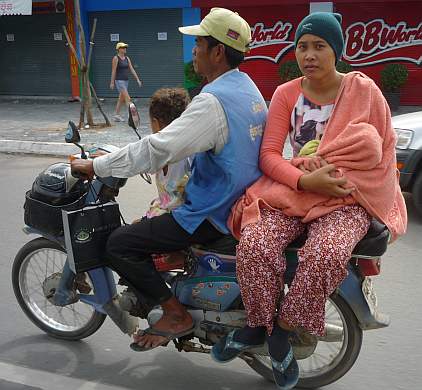
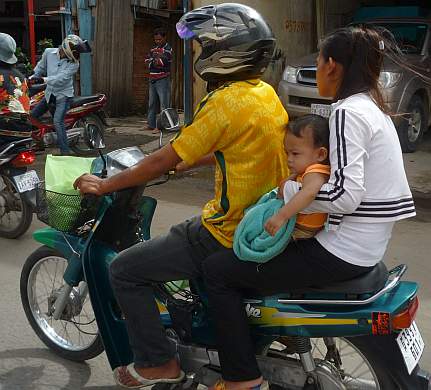
Earlier I noted that most of the time when a baby is carried on a motorcycle, it is wrapped in a bath towel. Here are a couple more examples of that practice. Maybe it's encouraged in the Dr. Spock Cambodian edition.
27 August 2011
Cambodia is a nation of small shops. Everyone is a business man or woman with some small shop or enterprise in or around the home. That's not necessarily the national model for business, but more a necessity. Just as a child might need a bicycle to get to school so the family needs a small business to earn a couple dollars a day for survival. The result is that almost anything can be bought on the street. 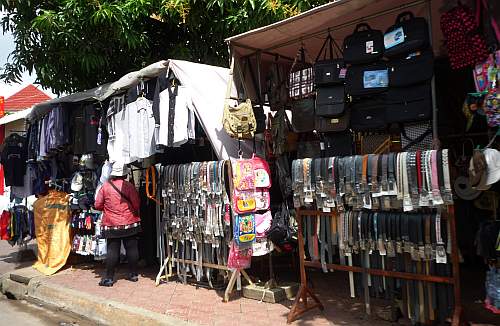
26 August 2011
They are pretty to look at but these chilis are HOT! The national diet of Cambodia makes the various common dishes less hot than would be found in neighboring Thailand, but every restaurant and rice shop has a bowl of these chilis on the table, and there are plenty of people who add them to whatever they are eating for that extra zing. 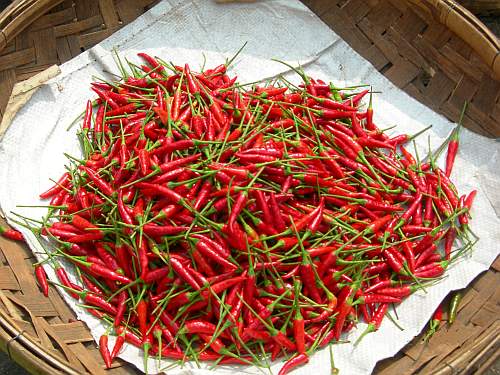
25 August 2011
"What?! What does playing with my feet have to do with selling bread?!" 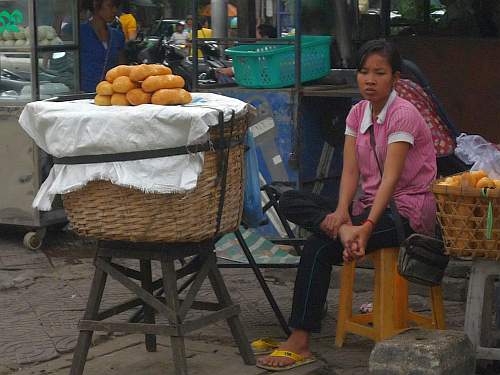
21 August 2011
 These are tour boats for tourists moored along the revitalized waterfront in Phnom Penh. Usually the boats are out of sight from the road but we are now in the middle of the rainy season--with very heavy recent rains--and the whole Mekong River basin is rising. As it does, it raises the level of this river, the Tonle Sap, which flows into the Mekong at Phnom Penh, and makes the boats visible. The rising Mekong River also causes the Tonle Sap to reverse its flow. Through most of the year it drains into the Mekong, but because the Mekong is so high now, the river reverses its flow and flows right to left into a lake near Angkor Wat, creating the largest freshwater lake in Southeast Asia.
These are tour boats for tourists moored along the revitalized waterfront in Phnom Penh. Usually the boats are out of sight from the road but we are now in the middle of the rainy season--with very heavy recent rains--and the whole Mekong River basin is rising. As it does, it raises the level of this river, the Tonle Sap, which flows into the Mekong at Phnom Penh, and makes the boats visible. The rising Mekong River also causes the Tonle Sap to reverse its flow. Through most of the year it drains into the Mekong, but because the Mekong is so high now, the river reverses its flow and flows right to left into a lake near Angkor Wat, creating the largest freshwater lake in Southeast Asia.
19 August 2011
Nothing on a Cambodian street should surprise one too much. The seemingly inexplicable sights or situations are usually just a matter of really different cultural practices. This man is carrying a cage full of what looks like sparrows. Down near the river, roasted sparrows are a simple fast-food snack from street vendors. Near the wats (temples), especially on certain feasts, the sparrows are bought by devotees and then released to gain good kharma to overcome evil in a person's life. (Those sparrows usually fly up into the air, make a big circle or two, and then return to the vendor and his cage, the only home they know.) What this man is doing with a cage full of birds I don't know but I doubt he's selling pets. 
18 August 2011
Motorcycle Loads #154 
17 August 2011
The crops come and go in Cambodia like in other countries. Now the peanut crop has come in and peanuts are plentiful on the streets of Phnom Penh. I wonder if this woman had to buy the peanuts outright or if she gets them on a commission basis? And is that her bicycle, or did she have to rent that also? And if she sells all the peanuts in her basket, how much will she make? One dollar, two dollars, for a full day of walking the streets? 
14 August 2011
The tap water in Phnom Penh—although it has received awards for its distribution--is not potable so everyone who has the money buys drinking water from several companies. When several of us lived together, we would buy ten 5.5 gallon bottles of water at a time, and even though I now live by myself, I still buy the water in ten bottle lots. This young man is one of two people who carried the 46-pound bottles from the truck down on the street up to my fourth-floor home. In addition to the weight, he has to skirt this dangerous stairway cut through the landing, going around the stairway hole on a nine-inch strip without a banister or railing. I gave each of them a dollar for their lugging almost a quarter ton of water upstairs. 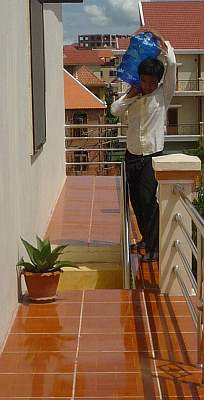
13 August 2011
Yesterday I made a needed visit to the barber training shop which is part of the Deaf Development Programme's job training project. It is interesting to note that now the students are not so concerned about cutting my hair as they once were. I interpret that as meaning they have more confidence in themselves and in their abilities. The young man on the right, who did most of the work, was not taking any chances, though. He worked slowly and methodically for forty-five minutes to cut the little hair I have remaining (and which probably couldn't justify forty-five minutes of attention). Then the young man on the left got involved, too, for reasons that I'm not sure of. He basically trimmed areas that had already been cut. Finally they asked if I wanted my beard trimmed. I had just trimmed it at home a few days ago with an electric clipper but these guys need all the practice they can get, especially with beards because Cambodian men don't have them, so I told them to trim just a little. That was another twenty-minute involvement, but in the end it all turned out well and I'm good for another couple months.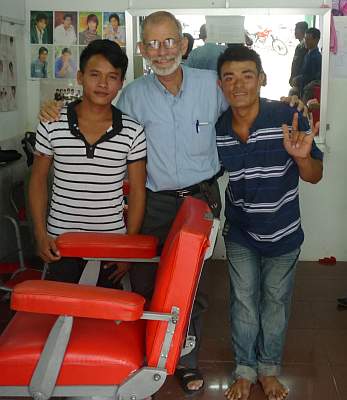
12 August 2011
Motorcycle Loads #153 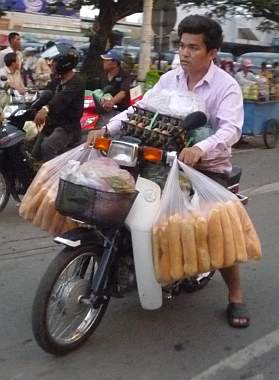
5 August 2011
Some fruits in Cambodia are seasonal, but some, like bananas and coconuts, are available throughout the year. This man pushes a cart of fresh coconuts for drinking. As each customer approaches, the vendor hacks off the top with a machete, inserts a straw, and offers a refreshing and healthy drink for a low price. It's hard work, though. Coconuts are heavy! 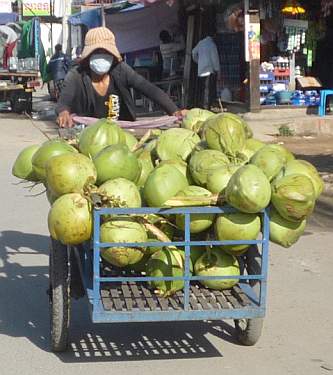
4 August 2011
Getting an early-morning flat tire on a bicycle repaired at one of the many on-the-street repair "shops." 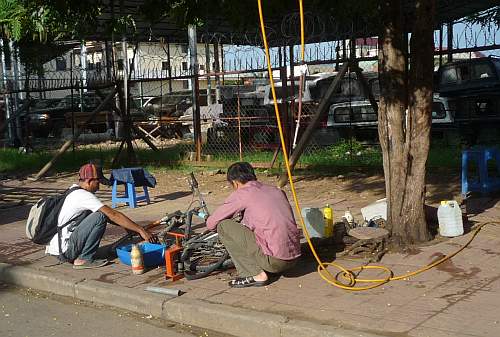
3 August 2011
"Would you like milk with your tea?" 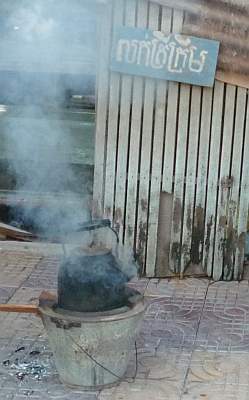
28 July 2011
Traditional tinkers are the stuff of folk lore, grandparents' memories, and nursery rhymes. There are probably some old-style tinkers still selling metal wares in various countries, but in many places the type of materials has changed even if the type of selling has not. Cambodia has some "tinkers" who peddle plastic goods from various types of vehicles, and then we have the basketware tinkers, too. This man is selling various forms of baskets and rice-sifting trays along with long- and short-handle cobweb cleaners for the high-ceiling rooms of traditional Cambodia houses. 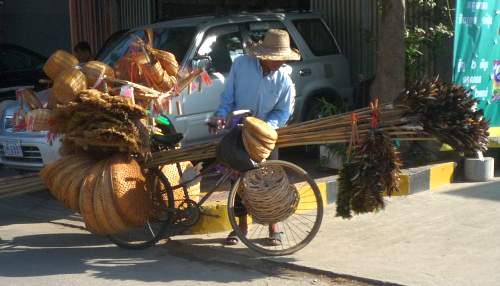
25 July 2011
Cambodian people have a fixation on sweeping the street in front of their homes and shops each morning. It's a ritual practiced by young and old in each household. To me the emphasis on morning cleanliness is ironic because the rest of the day they throw all trash on the street or floor. Paper napkins are SUPPOSED to be thrown on the floor! Sometimes, constrained by my upbringing, I leave a paper napkin on the plate when I am finished eating. The young woman coming to bus the table will take the napkin, throw it on the floor, and then put the plate in her dirty dish pan. This is a scene in a streetside restaurant after the morning breakfast crowd. 
24 July 2011
Imagine you want to have a couple friends over for lunch and you want to cook a LOT of rice. These pans are what you would use. They actually are pans for cooking huge amounts of rice served at weddings and funerals where there may be several hundred people being fed--all with the cultural concept that it's not a meal without rice. 
23 July 2011
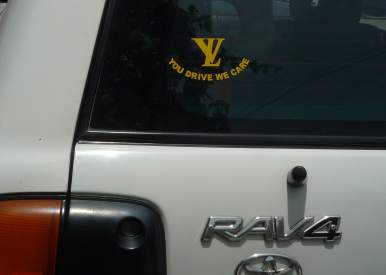
Drivers in Cambodia don't have stickers for car dealers on the rear of their vehicles. Here it's their favorite car wash--or several of them--that get the advertising. Click here for pictures of some labels.
22 July 2011
In the United States mothers often have to pile all the toddlers into the car when they drive the older brothers and sisters to school. It can be much the same in Phnom Penh except that mom piles them all onto the family motorcycle. 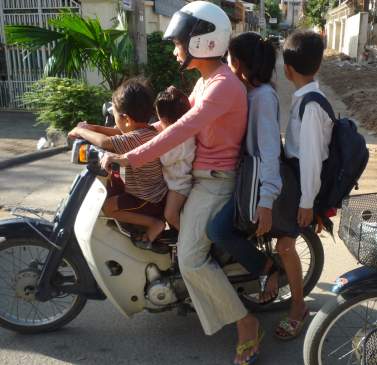
20 July 2011
Today was another hot Cambodian day with temperatures in the high 90 degrees but fortunately the meeting room of the Maryknoll office has air conditioning. I had just arrived home at 6:58 PM tonight after the weekly meeting, mass, and dinner, and noted that the thermometer read 95ºF and then the power went out. It is already dark here near the equator at that time so I went out on the small porch for my fourth-floor room and I could see the whole city was out. Only some buildings with generators had lights. No electricity meant no fans but also no computer. Thinking of what I could do in the dark, I remembered two old paschal candles I had from previous years and I lit them and set them in front of the rear window in the kitchen where there is usually a breeze. I was able to read my book there by candlelight until the power came back on 50 minutes later. I had already decided that if it didn't come back on before bed time, I was going to put some chair cushions on the porch and sleep out there where there was a decent breeze. 
18 July 2011
Although many aspects of Western, particularly U.S., culture are much desired and avidly sought in Cambodia, fortunately graffiti hasn't taken a great hold here. Still some graffiti vandalism is in evidence as seen in this photo of a wall along an open sewer. Note that the words are in Latin letters rather than in Khmer script. 
17 July 2011
Whenever you see a woman riding on a motorcycle with a towel covering something, you can be sure she's carrying a baby under the towel. Maybe baby blankets just aren't the culture here. After all, towels are just the right size for an infant and are readily available in a culture which doesn't have a lot of disposable income. It's a fairly universal custom--see a towel and there's a baby there somewhere. In this instance you can see a small hand peeking out from the edge of the towel. 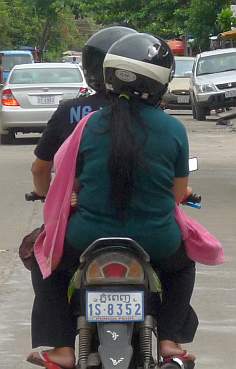
16 July 2011
Earlier I described how the family next door started developing their cooking space, a small outside area near the back of my house. First they moved their cooking to the center of the open space. Next they built four walls around the cooking area. Now, upon my return, I have discovered they have completely enclosed the previous back yard, turning it into a little one-room building which now has a blue metal roof. 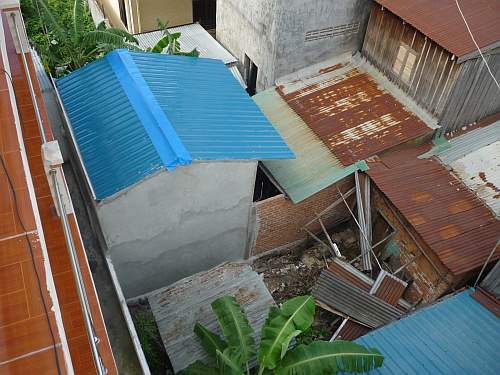
27 May 2011
About six months ago, there was a comment in this section of the website about the Phnom Penh Water Supply Authority receiving an award for improving the municipal water system. The director of the PPWSA spoke of people drinking water from the tap. Only if they're living dangerously, I would suggest. At the Salesian Sisters Technical Training School for girls in Tuol Kork, this somewhat elaborate water purification system has been installed to provide potable water for the students and faculty. It's only available in this one location and its purpose is somewhat nullified as you will notice the shelf full of common steel cups used by everyone. 
26 May 2011
Earlier this month there was a photo of a family adding an "island" to their kitchen layout, letting them prepare meals in the middle of the kitchen space. Apparently that prompted further planning and discussion, and now they have decided to add another feature of a modern kitchen--four walls. 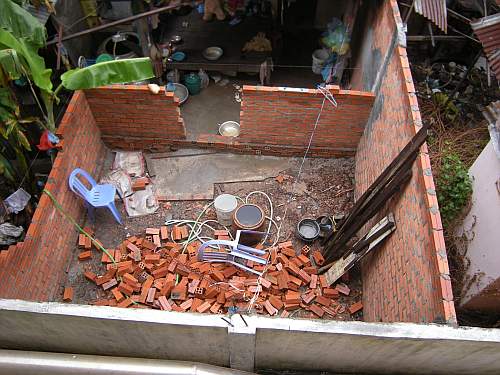
25 May 2011

Everyone and everything travels by motorcycle in Cambodia. Click here for pictures of children on the motos.
21 May 2011
About ten days ago, a small swarm of honey bees established itself on an outdoor chair outside of my front door, up on the fourth floor. Beekeeper friends told me it was a temporary swarm while scout bees were looking for a new location to create a hive for their queen. They said the bees would be gone in three or four days. They had already been there five or six days when I first pictured the swarm here and they were still on the chair this morning when I left at 7:30 AM. But when I came home this afternoon at 1:30 PM, this empty comb was all that was left. 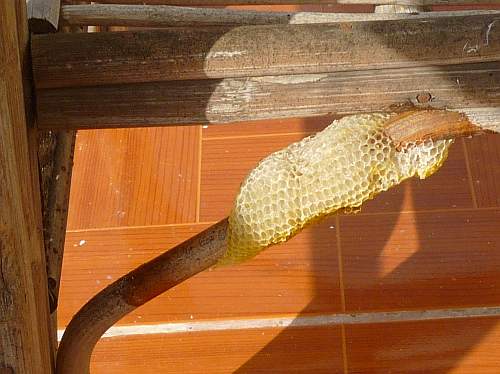
20 May 2011—Motorcycle Loads #152

Now THAT is a bread basket!
19 May 2011
Motorcycle Loads #151 A Tale of Two Cycles: The motorcyclist on the right has his girlfriend behind him. The guy on the left has a load of ....some tall thin vegetable like a BIG scallion behind him, making a nighttime delivery. Is there a storyline there? Probably not! 
18 May 2011
Everyone has a small business in Cambodia. Office workers, civil servants, ministry officials--all have some other income generating activities going on at home. Those that are most visible are the food operations. Women with little education or marketable skill will stake out a section of the street, buy a few plastic chairs and some big cooking pots, and they're in business. This woman caters to the breakfast crowd. She cooks in the metal pot on the charcoal burner and washes dishes(!) in the blue bucket. If customers want a drink, they use one of the three cups on top of the cooler filled with water. In Cambodian culture, it is not proper to have a rubbish bin where anyone can see it so all trash is thrown on the street and the woman sweeps it up at the end of the morning. 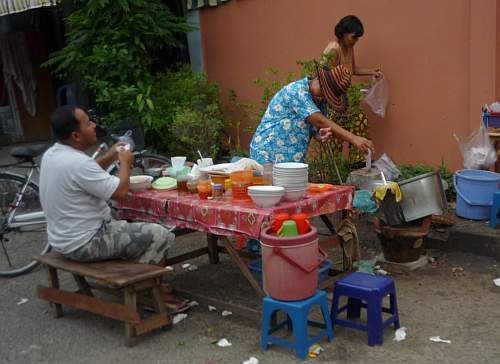
16 May 2011
Late last week I discovered this swarm of honey bees firmly attached to the underside of a chair on the narrow walkway around my fourth-floor room. They are not bothersome but I'm looking for a way to encourage them to migrate without doing any harm to them or to me. 
15 May 2011
Today is the third day of a four-day weekend to celebrate the birthday of King Sihomani. This morning, going by the royal palace on the way to Sunday mass, I saw this portrait of the king mounted on the royal viewing stand overlooking the Mekong River. 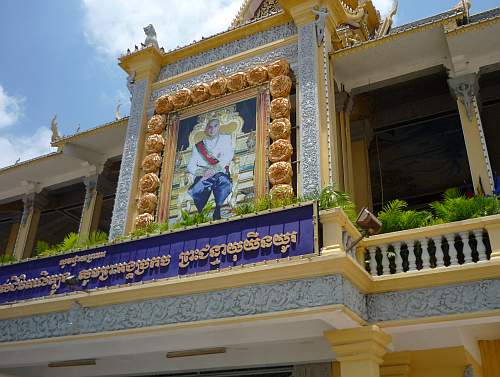
14 May 2011
"Hey, I can't wear a helmet! My girlfriend might call! There she is now....'Hi, Sweetie!' " 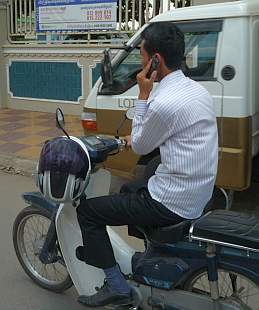
13 May 2011
Phnom Penh has an unbelievable number of cellphone towers. Click here to see some of them.
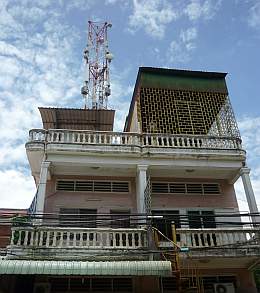
11 May 2011
This kitchen design is the forerunner of the "island" concept in the modern Western kitchen. Their island is just at ground level since they prefer to cook on the ground rather than standing up. 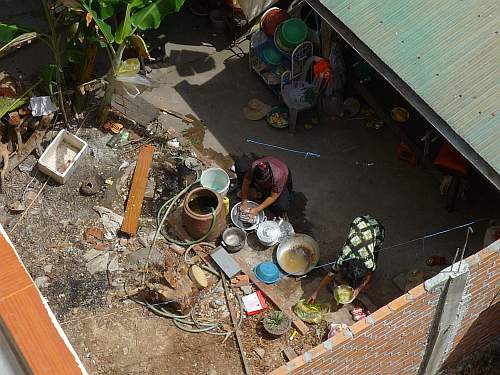
10 May 2011
Roast chicken to go, at a roadside restaurant on the highway to provinces in central and northern Cambodia. 
8 May 2011
"Hey, I paid a bundle to bleach this hair! I'm not covering it up with that helmet!" 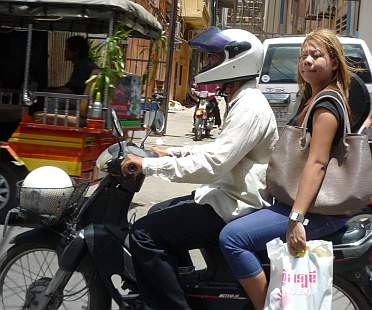
7 May 2011
Especially in the mornings these mobile market carts are visible on Phnom Penh streets. They basically deal in perishables: green leafy vegetables in front, tomatoes and other solid vegetables in the middle, and fresh meat at the back. Women who haven't got time to run to the big market for something can usually find simple things here and it's a boon to mothers with young children who can't always drag them all to the big neighborhood markets. 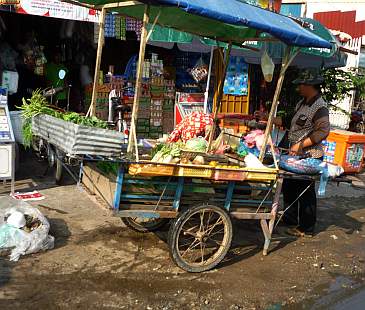
6 May 2011
"Hey, I've got my helmet right at hand, ready to use at a moment's notice! You never know when an emergency might come up!" 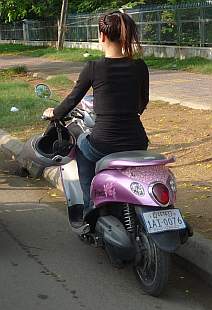
5 May 2011
This woman is putting out filleted fish to dry in the sun all day long on the street before they are served in the restaurant in front of her. Hygiene is not a large component of the restaurant culture so I always hope that at least the bacterial elements that settle on the food setting outside during the day will be killed by cooking, even if the toxic elements like exhaust fumes, etc., are still potent. 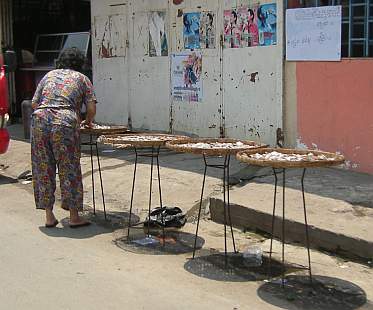
2 May 2011
Coconuts are extremely healthy and good for you, but there's no getting around the piles of waste generated when the coconuts are trimmed and the shells cut away to give access to the milk and coconut meat. Each coconut can leave behind 1-2 pounds of thick hulls. Luckily it's all biodegradable even if it's not completely reusable like a bottle. 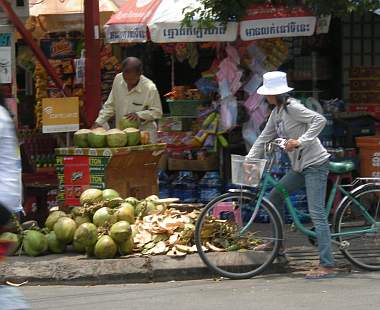
1 May 2011
Today the temperature was 99º but this young woman was certainly bundled up, not against the cold but against the sun. Cambodian women have thoroughly accepted the idea that white is good and black is bad and will do anything to keep their skin from getting darker. It really is sad. 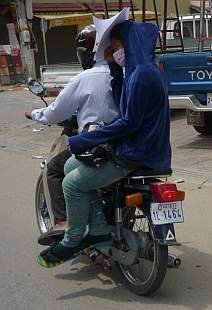
30 April 2011
This scene isn't uncommon--seeing a family returning from the doctor with an IV bag on a pole out the car window or held aloft like this--but it's difficult to get a good picture because everyone is moving. Our local correspondent, Jim McLaughlin, former Maryknoll lay missioner in Cambodia, was able to get this shot a few days ago. It seems it would be a little less dangerous for all the family if the mother held the baby AND the IV bag. 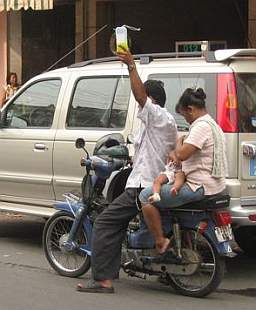
29 April 2011
This little girl, who should be in school--but isn't--scavenges for trash to be recycled in the garbage heaps along a Phnom Penh street. 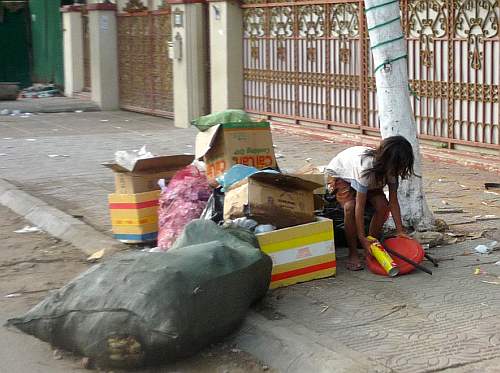
27 April 2011
Sometimes clothes are sold in piles on the sidewalk, sometimes from racks along the street. Market stalls like these are set up every morning and then taken down and hauled away every evening. I'm sure the proprietors don't get rich but they must make a living or they wouldn't keep selling here. Of course, using the sidewalks for commerce means they're totally useless for walking. 
10 April 2011
Hey, what does Starbucks have that Tanna's doesn't...other than air-conditioning, clean ice, four walls, wi-fi, etc.? This is a little coffee stall outside of the Russian Market, the favorite spot for tourists looking for souvenirs. I'm not a coffee drinker so I can't speak to the claim of the best iced coffee. 
6 April 2011
Do you think the people in this house hear the trains go by? They might...but only infrequently. There are only two trains a week because the 80-year old line--which has never been maintained--doesn't go to the border and is too dangerous. The two trains a week won't really bother anyone. They travel at 12 MPH because the tracks are in such bad condition that they won't support any higher speeds. 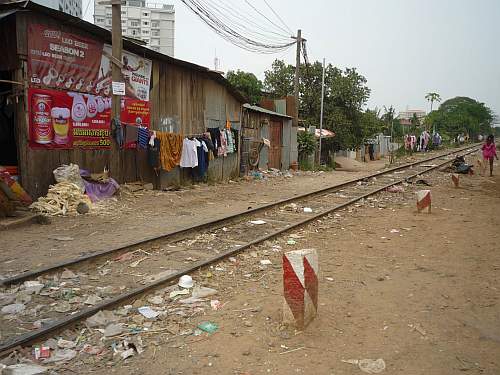
5 April 2011
These are three pieces of filleted fish left in a wicker tray out in the sun to dry. It certainly doesn't look appetizing, it smells bad, and it's probably a really bad idea from a hygiene idea, but it's part of daily life in Cambodia. All sorts of meat, fish, vegetables, and fruit are put out in the sun every day to dry out and acquire a reasonable coating of street dirt before cooking. 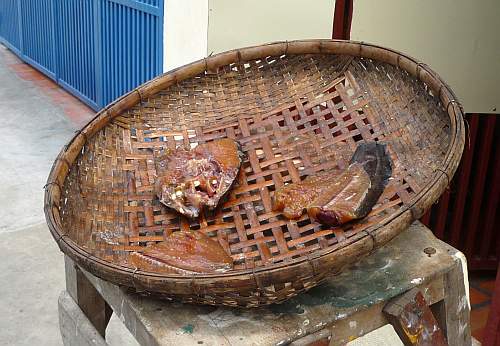
4 April 2011
Ching Ming is an especially important holiday in Chinese cultures, a day to go out into the natural environment and tend the graves of deceased loved ones. It is a solar feast, falling on the fifteenth day after the spring equinox, April 5th this year. In majority Chinese societies, it is a full holiday but in Cambodia people of Chinese ancestry adapt as their circumstances permit. Here on the weekend before a woman prepares offerings for the spirits of her relatives. Her offering includes a paper automobile to serve the needs of an ancestor. 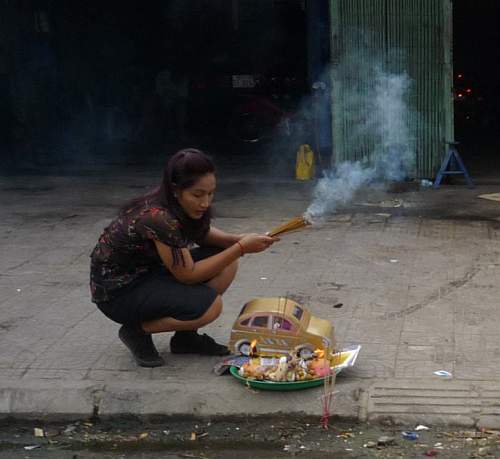
2 April 2011
You've heard of "big box" stores in the U.S., places like Best Buy and Wal-Mart, well, this is a "no box" store. Everything is just in one big pile on the street. It makes shopping fun and different. 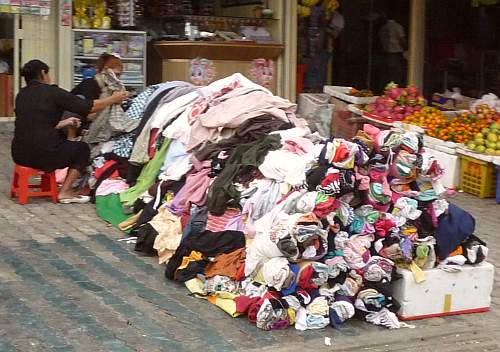
21 March 2011
Many people in the West have donated blood, some of them quite often. Donating blood is not so common in Asia where there differing attitudes about the body and maintaining its integrity. There is no national blood collection system and each time a person needs blood for surgery, there is a frantic search for possible donors. The Catholic church collaborates with the blood collection office in Phnom Penh and three times a year sets up a "bloodmobile" in the church yard during the morning masses.
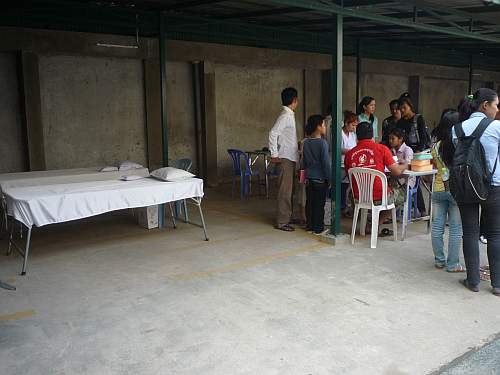
Bloodmobile
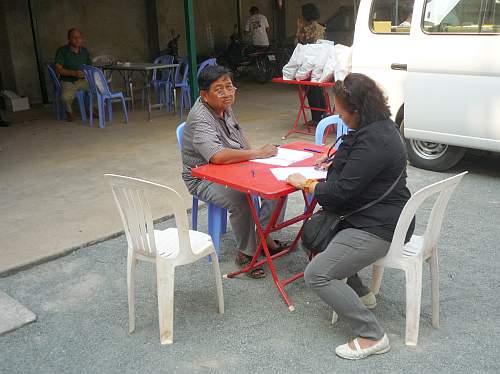
The blood collection crew loads all their equipment into a van and sets up outside with just a carport cover for shelter. There's a concern about hygiene but collecting blood in a parking lot is necessarily different from a Red Cross blood center in another country. Two folding cots are set up for donors, a folding table is prepared to register donors, and another folding table in the background offers the traditional cookies and juice after blood is collected. Thirty-five units of blood were collected in the last drive at the church, and the blood center was very pleased.
20 March 2011
Not surprisingly, shortly after the nuclear problems started developing in Japan, we started getting text messages on our phone here telling us in dire terms that, if it rains, DO NOT let the rain touch our skin, we should use umbrellas, etc. Of course there was no danger here, the prevailing winds blow east from Japan not west, etc., but that doesn't stop the twits who send such nonsense, adding, of course, SEND THIS TO EVERYONE IN YOUR PHONE!!!! The US Embassy in Phnom Penh did send out a message a day later but it was calmer and said that while there was no danger here, updates could be obtained from embassy websites which they supplied. No one in Phnom Penh has been worried, but this morning when I got up, I saw this rush toward the open door! I've often heard how animals sometimes seem to know in advance about things like earthquakes.... 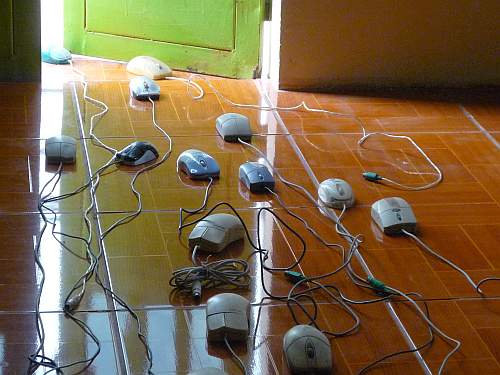
19 March 2011
 |
 |
This is a water bottling plant along an open sewer next to Street 105 in the area where the Deaf Development Programme office is located. The plant certainly isn't much to look at. There was no attempt whatsoever to do more than put up just a basic building, with no attention paid to aesthetics. I'm hoping they paid a bit more attention to hygiene, but there's no certainty of that. They didn't even bother to include toilets inside the building but put up little outhouses in the back. I'd like to know which brand of water they bottle so I can avoid it.
16 March 2011
Big brother takes little brother somewhere, walking down the middle of a street in the morning rush hour. There are no sidewalks and, even if there were, most Cambodian people would not use them. They have not made the mental distinction between walking on a narrow dirt track in the village, a road that sees maybe one car every day or two, and walking on the streets of a city. A good percentage of the urban population have little sense of how to live in a city with streets and cars. 
15 March 2011
This is Coconut Corner near my house in Phnom Penh. That's not its real name but this corner and the one opposite it are piled high with coconuts every day of the year to satisfy the national thirst of Cambodia. Coconuts are cheap, tasty, healthy, nutritious, and were around long before Coca-Cola and the canned soft drinks. Local people can be seen drinking one with a straw throughout the day, and for some poor people, it may be their only meal for the day. If someone really wants to splurge, a cold coconut can be bought from the orange cooler. 
11 March 2011—Motorcycle Loads and Passengers #150
"Man, he hits another bump like that one and it's going to be nothing but fruit salad!" 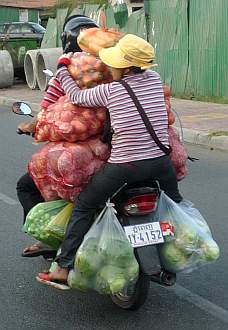
4 March 2011
The Russian Market is a tourist's dream, lots of attractive and desirable items to buy and then just the experience of the narrow,dark, crowded walkways through row after row of vendors like these selling T-shirts, khramas, skirts, bags, jewelry, and much more. 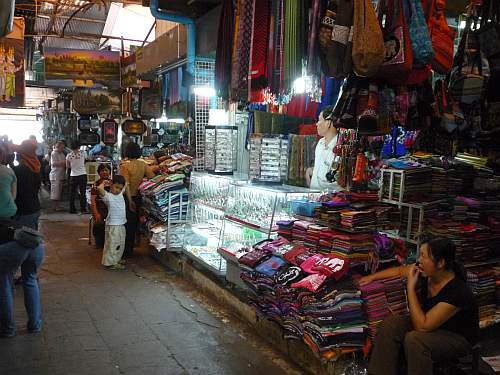
1 March 2011
Cambodia lost an educated generation to the Khmer Rouge and desperately needs to educate its present generations. But the school day is only 3 1/2 hours (7:30 to 11:00 AM) and Thursday is a cleaning day. If the students come at all on Thursday, they bring a broom like this one on a student's bicycle and sweep the dirt in the school yard . And then they go home after less than an hour. I was asking if the students also go to school on Saturday, since they miss Thursday, but never got a clear answer. I'll come back to that one. 
19 February 2011
Houses are designed in the urban areas of Phnom Penh not primarily as living spaces but as commercial spaces. The ground floor is open the width of the house to the street, and every morning various kinds of goods are rolled or carried out of the living room where they are stored overnight to display cases set up in front of the house. Here a family with telephone company markings on the building has one display in front for telephone SIM cards (left) and then another for snacks and drinks. One of the parents or one or more of the children might also work in some office or the civil service. 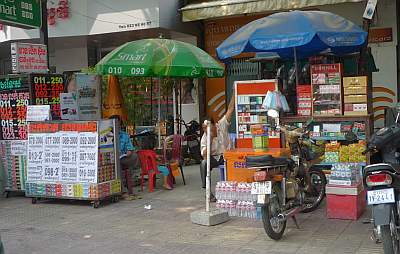
18 February 2011
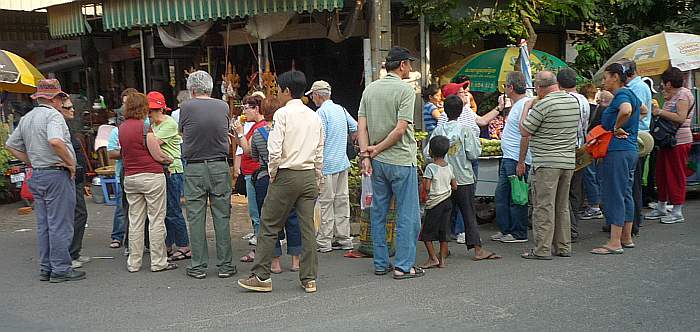
Today, when coming out of the Russian Market, a favorite destination for souvenir shoppers, I found this group of tourists on the corner, happily munching away on ears of corn. Most tourists are deathly afraid of eating anything outside of the "safe" restaurants but they must figure that the hot corn, still wrapped in its shuck when they buy it, is safe enough. And they should be right.
17 February 2011
Several articles here have noted that the most obvious lingering indicator of the former French presence in Cambodia is the French baguette, often seen stacked along the sides of the roads. Once a year Phnom Penh is treated to another indication of its colonial past when a new year sign in French is erected at Wat Phnom. Obviously the authorities are in no great hurry to take it down. 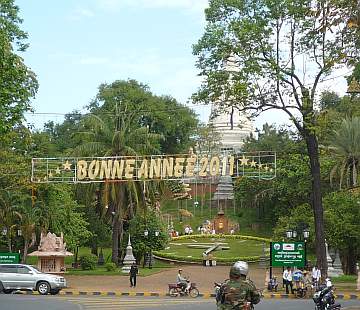
16 February 2011
There aren't many seasonal indicators in Cambodia—no autumn leaves or icy weather or things like that--but there are changes in life on the street that are linked to different times of the year. One indicator is the change of the fruits and vegetables and other foods that the vendors sell on the streets. Right now corn is in season, and corn on the cob is readily available. The vendor on the left has a plastic bag of hot boiled corn on the back of her bicycle--and a couple customers anxious for it--and on the right is a motorized cart selling ears of corn along with some other foods. People eat the corn plain--without butter or salt--but it is quite sweet and good.
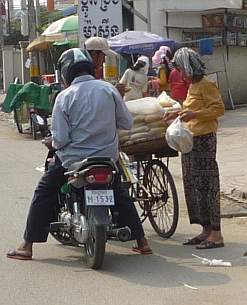
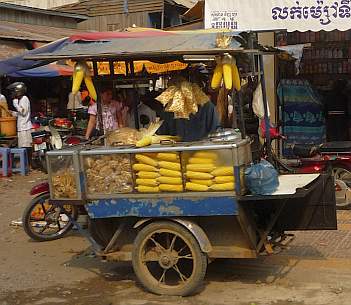
14 February 2011
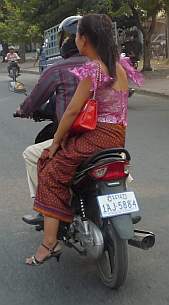
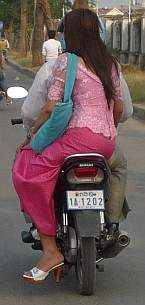
I've not seen a bride and groom on the back of a motorcycle but it is certainly common to see formally dressed women like these going to an evening wedding celebration. Probably for these women it's just a matter of unconcern, but many younger women claim they don't wear their helmets when dressed up because "It'll mess up my hair!" So does brain surgery.
12 February 2011
A very young customer making a purchase from a street vendor. 
11 February 2011
"All this salt kinda makes me thirsty. Now if I just had some pretzels!" 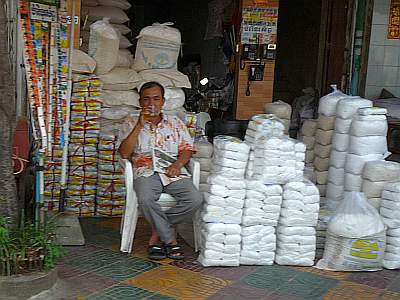
10 February 2011
The owner of the little bike repair "shop" on a sidestreet sidewalk, replacing the rear inner tube. Two young men repairing another tire while the owner fixed mine. Then this morning I had a flat tire on the rear wheel. The man two corners down where I take my bike for that kind of repairs found a nail in the tire and repaired it for 50¢. Then when I came out of a meeting this evening, I found it flat again. Another nearby street repair place found a rather large hole in the tube near the valve so I had the tube replaced and that cost $3.
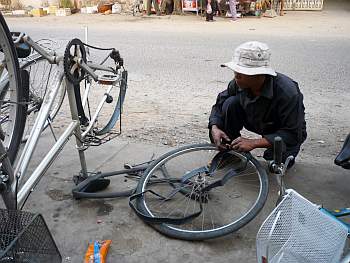
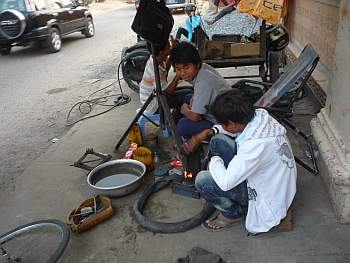
Yesterday I got my bicycle repaired. It cost me $13 to have broken spokes replaced and to get new fenders, new handlebars, new handgrips, and a new light. It took a while to get the job done because, strangely, there is only one shop among the 10-15 along one street that will replace spokes and "true" a wheel. I had to wait for the owner there to come back from his holiday for the Lunar New Year.
7 February 2011
This morning I found this big rat squashed on the street in front of my house. Now rats are rather wary and quick so I have always wondered at the more-than-I-would-expect number of rats that get run over. I suspect they are actually caught in rat traps but because good Buddhists don't kill animals, the rats are knocked over the head to make them unconscious and then left in the street for a car to give the final blow. You have to admit, that even before this one was flattened, it was a good-sized rat! Our landlady's kittens need to be careful! 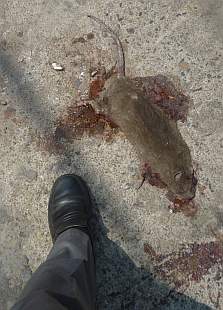
6 February 2011
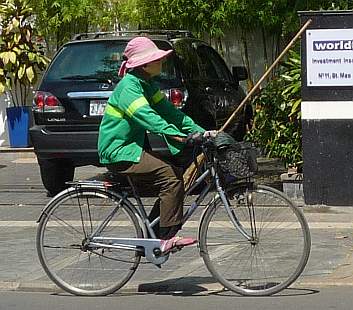
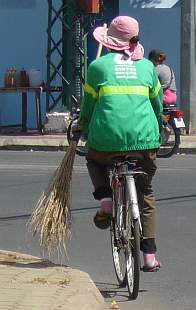
With golf returning as an Olympic sport in 2012, there is speculation that quidditch will be introduced in 2016 and many countries are starting to form teams in anticipation. This woman, carrying a Comet broomstick (one of the cheaper and more common brands) is seen here going to the quidditch tryouts for the Cambodian team. Her green jacket indicates she is a sweeper with the Cintri street cleaning company so her experience with a broom may come in handy.
5 February 2011--Trash to you, Gold to me...
Something is really wrong in a society where a substantial percentage of the population supports itself on trash and garbage. This man is taking a break after pushing his cart through the streets, looking for recyclables, for many hours. He may get enough to feed himself and his family for today. The saddest part is that this sleep break may be the high point of his day, the time when he is most at peace. 
4 February 2011
Notice the man in the left front seat reading the newspaper while the car travels along a busy Phnom Penh street, heading out to the provinces. It must be a right-hand drive car, you might think, and the driver is on the right side. (Cambodia allows both right- and left-hand drive cars, a consummate insanity!) But, no, this is a left-hand drive vehicle, and the driver is on the left. It just happens that this is a taxi with eight to ten people inside, and the driver has the passenger reading the paper between himself and the door. The driver sits halfway on top of the gear shift and drives with his left hand. Of course, he can't see anything out the side window because of the newspaper, but, hey, he's driving forwards not sideways! 
1 February 2011
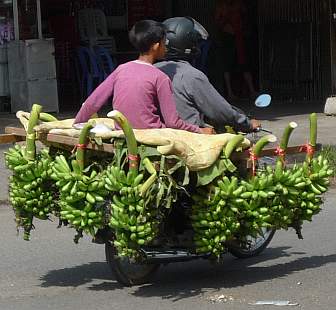
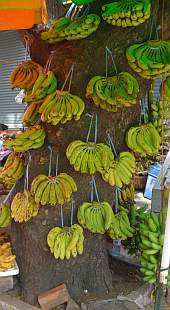
Every day thousands of stalks of bananas are brought into Phnom Penh from the countryside and then make their way around the city on motorcycles like this one.
Other bananas are more stationary and, like these bunches attached to a tree at an intersection, just stay in one place and wait for the people to come to them.
31 January 2011
The lunar new year is coming in a few days and many shops around Phnom Penh are offering decorations for the Chinese and Vietnamese families who will be celebrating this festival, the most important one of the year after the Khmer new year. 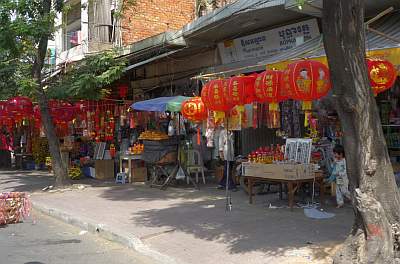
30 January 2011
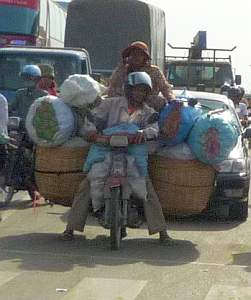
"Hey, lots of motorcycles have saddlebags! Mine are just a little bigger...."
29 January 2011
This is a porch area in front of my landlord's front door. He and his wife and two daughters and elderly mother-in-law live in this ground floor flat while I live on the fourth floor. The picture shows 25 of the 27 shoes I saw in front of their door one day this week. Several more were scattered just out of camera range. Cambodian people just leave shoes anywhere and this mixture of sandals is a commonplace sight. Consider, too, that these are all women's shoes and the women are also each wearing another set. Notice also the concrete ramp at the left. That is so the family can take their three motorcycles into the living room at night. 
27 January 2011
Mothers like this one don't have the money to send their children to school with bribes to pay off the teachers and they can't leave the children alone, so the kids accompany the parents and learn the trade of collecting recyclable trash. And they will probably be doomed to the same fate since they won't have any education. 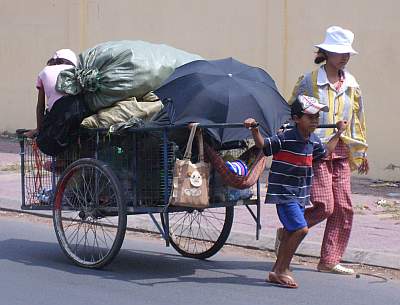
Today was "Take your child to work" day in Cambodia—just like every other day. An open umbrella like the one on this cart usually means there's an infant underneath.
26 January 2011
Notice the close-up of the fire hydrant. This is one of two styles I have seen in Cambodia. There aren't that many hydrants in the country, maybe only a couple dozen—if that many, and it's not unlikely that none of them work. I have always been intrigued by their strange—to me—design. I'm particularly curious about the vertical flange or shield on the right side. What is the function of that? A best guess is that it may be part of a cover that fits over the whole unit and the movable part was long ago stolen to sell as scrap metal. (Any ideas from the reading audience?)
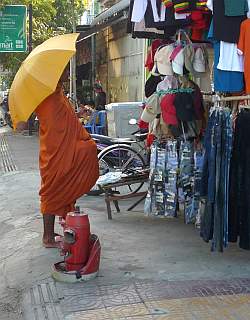
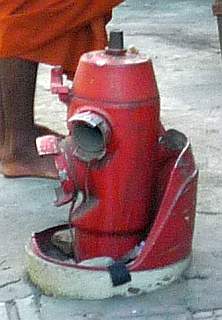
Every time in the last month I rode my bicycle past this fire hydrant near my house, I thought that I would like to take a picture of it to show people what a hydrant looks like in Cambodia. Today I had my camera ready, but just as I was preparing to click the shutter, this monk appeared on his daily rounds, begging food and money to feed the monks and all the people they take care of. Those are begging bowls for rice and food and money under his robes. Monks are another subject I have been collecting photos of, so I thought that was a bit of a bonus.
25 January 2011
Today I was bicycling back from Koh Pich, the island where the stampede occurred and 350+ people were trampled, and between the island and the Australian Embassy, I found Sambo roaming around. That may be her home, and it would make sense because she has to walk every day over to Wat Phnom, and this field is do-able, about two miles away. The nice thing is that she is alone, without all the people crowding around her, and she must appreciate the openness of the field which is about three acres. Now if there were only more trees and a few other elephants. 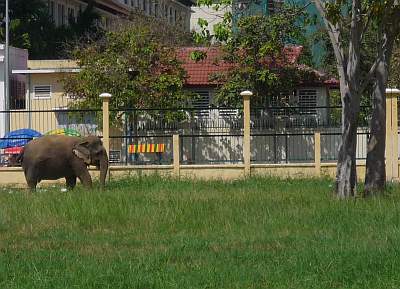
23 January 2011
One of the fixtures of Phnom Penh is Sambo the elephant. Every morning her mahout walks her through the streets to the park around Wat Phnom where she gives rides to the tourists and the tourists feed her with bananas (bought from the mahout, of course). Sambo has been around a long time and there was a great outcry when the municipality decided last year that she should not be roaming the city. There was enough consternation that the city relented and now Sambo is back on her beat. 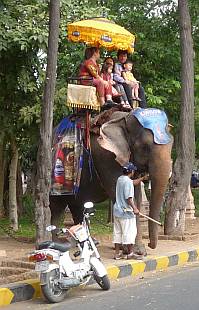
22 January 2011
Riding motorcycles is a normal, everyday part of life in Cambodia. More than 500,000 motorbikes are registered in Phnom Penh alone. From their youngest days, babies and toddlers ride with the wind in their face so it's not surprising that kids appear on the streets on motorbikes just about as soon as they can reach the controls. Safety? Not a concern in Cambodia.... 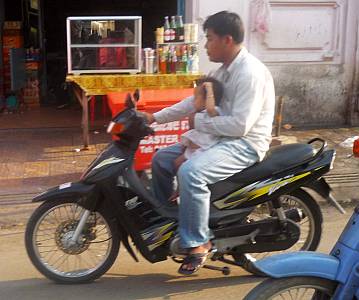
21 January 2011
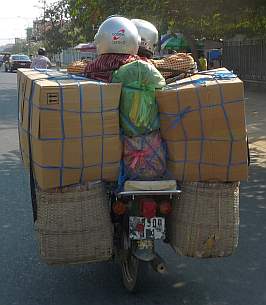
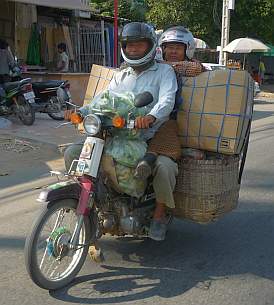
Scenes like this confirm for me the ingenuity, determination, and indomitable spirit of the Cambodian people. "We CAN do it!"
20 January 2011
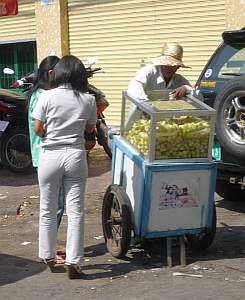
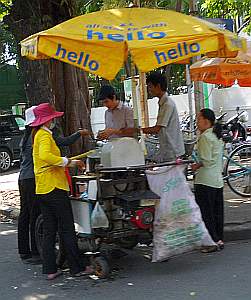
Although soft drinks and processed junk foods are rapidly becoming more popular, the snacks and drinks of choice are still the natural ones. Coconuts are available everywhere for drinking and a variety of fruits can be had on the street. One snack food seen everywhere is sugarcane. The vendor on the left is selling chunks of sugarcane, about two inches in length, that can be chewed to get the sweet juice. The vendor on the right, after stripping 18" sections of sugarcane, runs the sticks through a squeezer, like an old washing machine wringer, that extracts the juice into a glass of ice for a delightful drink.
18 January 2011
Just as I was leaving the Deaf Development Programme office this afternoon, I looked out the window and saw a group of men watching a cock fight. I haven't seen too many of these "events" before but from the number of roosters kept under large wicker baskets around the city, I'm sure they are not uncommon. 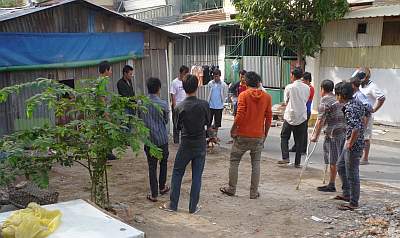
17 January 2011

The re-energized Phnom Penh waterfront, with new sidewalks and tiled areas, on a bright Sunday morning with a strong breeze among the flags of various nations.
3 January 2010
He doesn't have his seat belt on. But then with 15-20 people in the van probably no one else does either. Actually the seat belts have probably long since been removed. But that's OK...it's only a four or five hour drive to the coast. 
